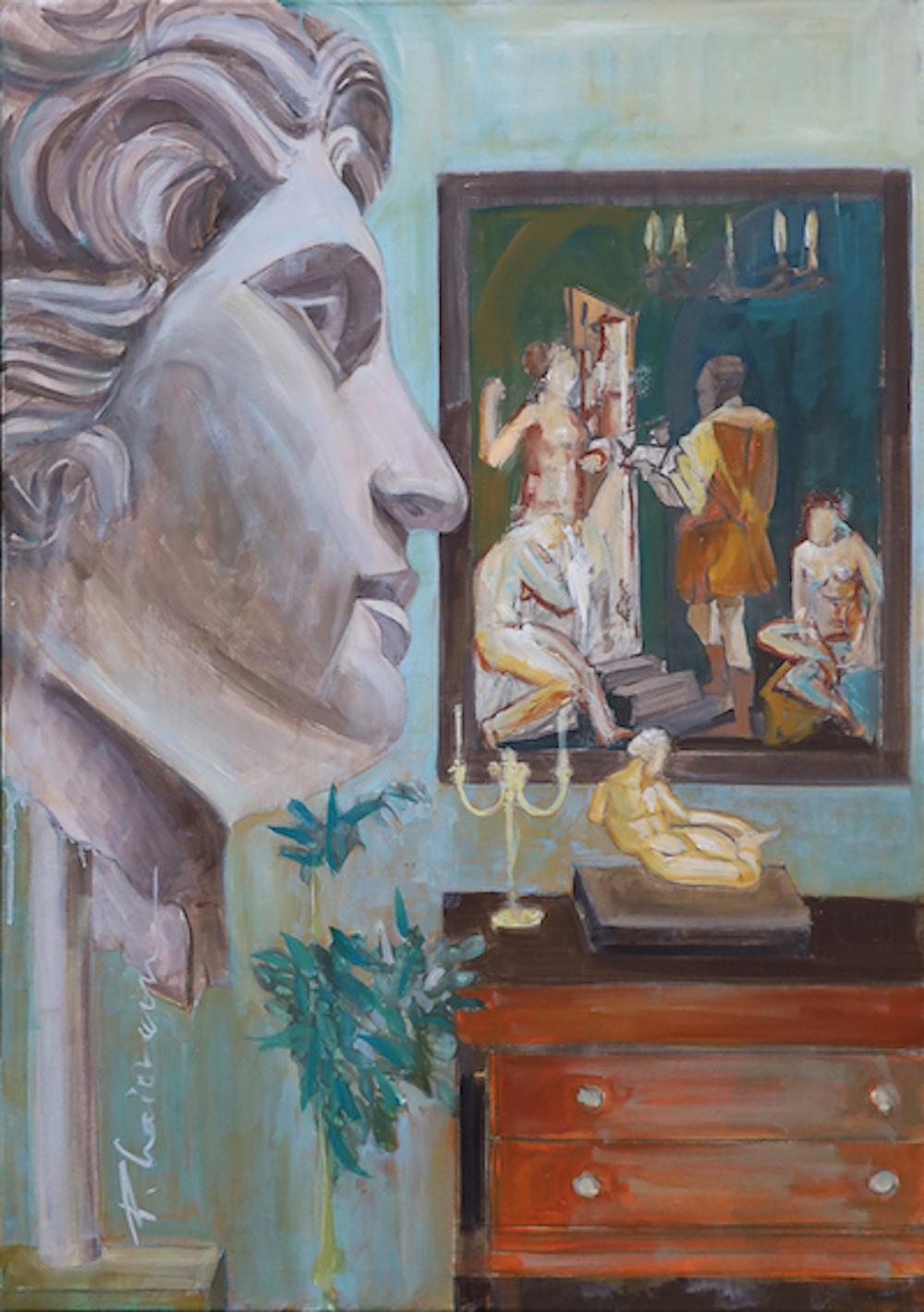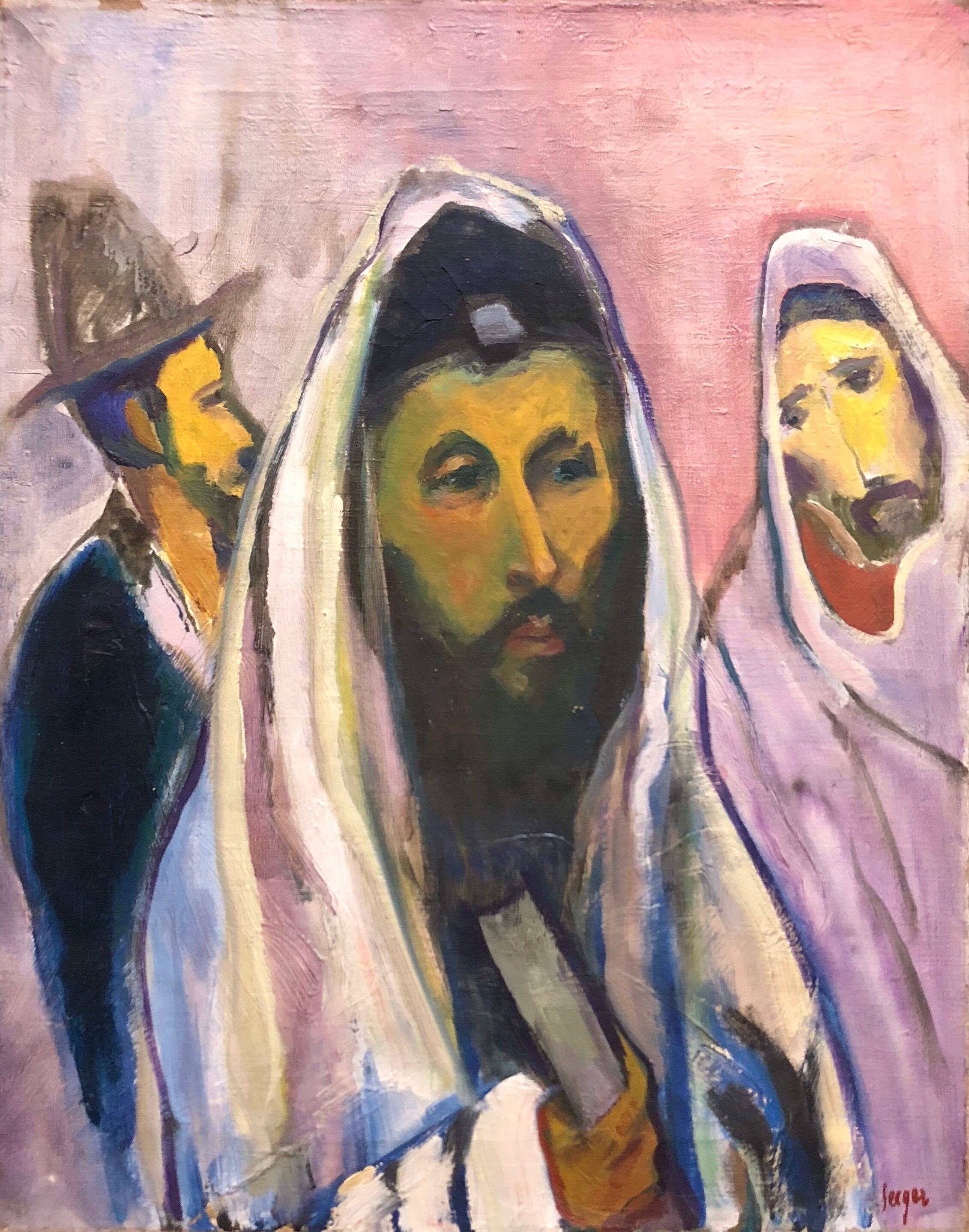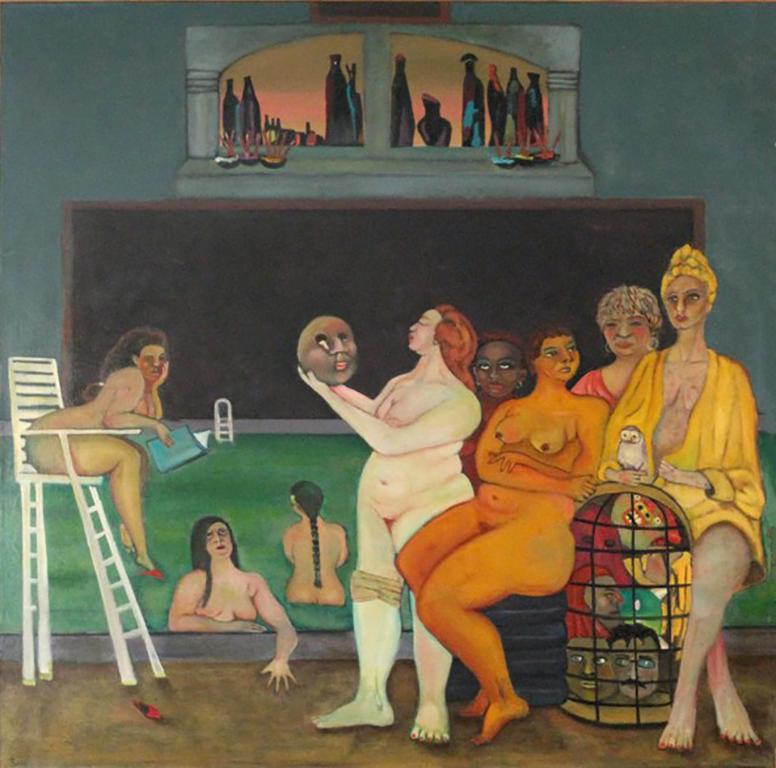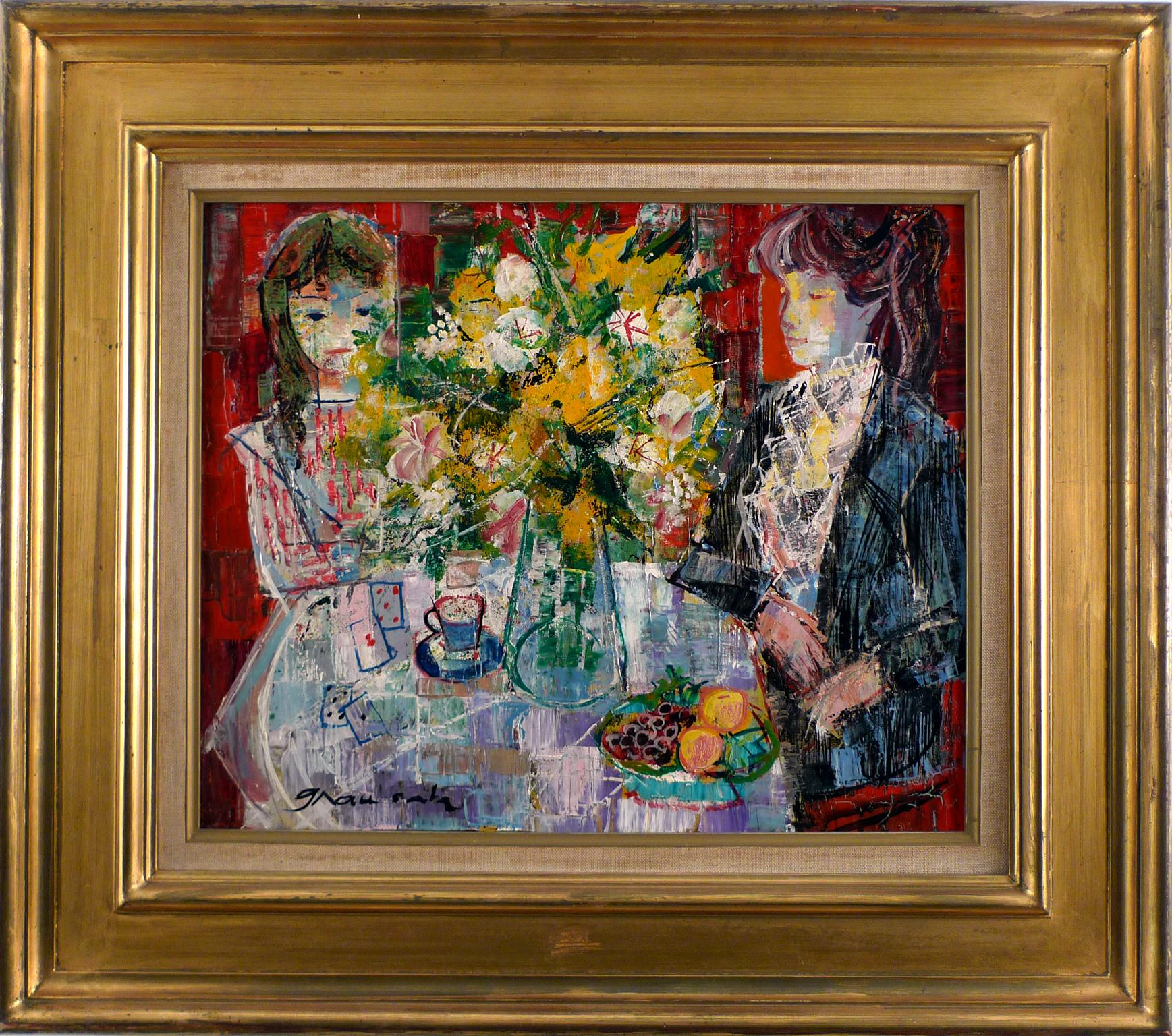Items Similar to "Les Musiciens", 20th Century Oil on Canvas by Spanish Artist Celso Lagar
Want more images or videos?
Request additional images or videos from the seller
1 of 13
Celso Lagar"Les Musiciens", 20th Century Oil on Canvas by Spanish Artist Celso Lagar1928
1928
About the Item
CELSO LAGAR
Spanish, 1891 - 1966
LES MUSICIENS
signed "Lagar" (lower right)
signed again, located & dated "Lagar / Paris 1928" (on the reverse)
oil on canvas
23-3/4 x 28-3/4 inches (60.5 x 73 cm.)
framed: 29-1/8 x 34 inches (74 x 86.5 cm.)
NOTE:
THIS WORK IS ACCOMPANIED BY A CERTIFICATE OF AUTHENTICITY ISSUED BY “ARCHIVO CELSO LAGAR”.
PROVENANCE
Private Collection, Paris
Celso Lagar Arroyo (Ciudad Rodrigo, 1891 - Seville, 1966) was an expressionist Spanish painter of the first generation of the School of Paris, where he lived most of his life. He was influenced by avant-gardes of all kinds, such as cubism and fovism. He painted mainly landscapes and still lifes. From a personal point of view, he is a depressive person and completely dependent on his wife, the French sculptor Hortense Begué.
From his native Ciudad Rodrigo, he went to Madrid to be part of the workshop of one of the best sculptors of the moment, Miguel Blay. During 1910 and 1911 he visited Barcelona. Later he studied sculpture in Paris in 1911 advised by Blay, where he met Joseph Bernard, his friend Amedeo Modigliani and his future wife, the French sculptor, Hortense Begué. It will be precisely at that moment when, gradually, he leaves the sculpture in favor of painting.
The outbreak of the First World War will mean, in the life and work of Celso Lagar, the beginning of a new stage. He remained in Barcelona during the war, where he achieved a certain recognition, which allows him to return to Paris. In 1919 he settled permanently in France. His time until the end of the 30s, is the moment of his greatest splendor of the artist. He manages to exhibit his works in the best Parisian galleries, his production is abundant and constant. Both in his residence in Paris and in his rooms, since 1928, in Normandy he will develop an artistic production with very specific themes: still lifes, Spanish reminiscences, landscapes and his celebrated circus scenes. After the period of avant-garde influences of all kinds (Cubism, Fauvism, Vibrationism, Biologism, Simultaneism, Ultraist, ...), Celso Lagar will find his own path marked mainly by Goyesque and Picasian inspiration. Critical and public recognition increases.
With the onset of World War II, its golden age will end. Lagar and Hortense are forced to take refuge in the French Pyrenees amid very difficult living conditions. His return after the liberation of Paris did not have such an impact. Lagar will continue with the same themes and techniques before the war but the public is already looking for new content. Gradually, success fades and economic hardships affect the couple.
At this time around the year 1950, his wife Hortense enters the hospital Broca and in 1955 dies. Lagar falls into a deep depression and will enter the psychiatric hospital of Sainte Anne. His artistic work ends completely. At that time, by court order, two auctions of the works that remained in his workshop are held, to pay for his stay in the asylum. In October 1964 he returned to Spain living in Seville with a sister until his death on September 6, 1966.
His paintings are found in numerous museums throughout Europe, such as: La Rochelle, Goya Museum in Castres, Honfleur (France), Petit-Palais de Geneva, Reina Sofía National Art Center Museum, Casa Lis de Salamanca, Carmen Thyssen Museum ( Malaga) and in prestigious collections such as Crane Kallman (London) or Zborowski (Paris).
He was illustrator of several magazines, among them, the Spanish Magazine Nova, Un enemic del Poble and Troços.
- Creator:Celso Lagar (1891 - 1966, Spanish)
- Creation Year:1928
- Dimensions:Height: 23.63 in (60 cm)Width: 28.75 in (73 cm)
- More Editions & Sizes:60 x 73 cm.Price: $38,179
- Medium:
- Movement & Style:
- Period:
- Condition:
- Gallery Location:Madrid, ES
- Reference Number:1stDibs: LU1281112772572
About the Seller
5.0
Vetted Seller
These experienced sellers undergo a comprehensive evaluation by our team of in-house experts.
Established in 1977
1stDibs seller since 2019
21 sales on 1stDibs
Typical response time: 2 hours
- ShippingRetrieving quote...Ships From: Madrid, Spain
- Return PolicyA return for this item may be initiated within 14 days of delivery.
More From This SellerView All
- "Interieur aux Fleurs Jaunes" 20th Century Oil on Canvas by Emilio Grau SalaBy Emilio Grau SalaLocated in Madrid, ESEMILIO GRAU SALA Spanish, 1911 - 1975 INTERIEUR AUX FLEURS JAUNES signed "Grau Sala" (lower left) signed again, located, dated and titled "Grau Sala, Paris 61, Interieur aux fleurs jaunes" (on the reverse) oil on canvas 15 x 18-1/4 inches (38 x 46 cm.) framed: 23-1/2 x 26-1/2 (59.5 x 67 cm.) PROVENANCE Private Parisian Collection Interieur aux fleurs jaunes This interior with two female figures where also the plans made in different colors are drawing the composition. The abundant pictorial material distributed in geometric portions, gives life to the tablecloth and mother and daughter figures, in black and white colors of the jacket, while the black line takes care of the environments so as not to separate them. The fruit bowl and flowers give a cheerful touch with their pastel tones. Emilio Grau Sala came from a family of artists. He was born in Barcelona in 1911 and his father, a good cartoonist, had been one of the promoters of the "Salon des Humanistes" and made his exhibitions normally in "Sala Parés", Barcelona. His first works were exhibited at the Salon des Independents. In the years 1930-33 he had painted under the influence of Cubism, especially that of Torres García. It is from that time a painting of the port of Barcelona, geometric and structural, which completely anticipated what would later be his work. His personality began fully painting watercolors and oils with a certain fantasy character, with a point of decorative instinct and themes full of naivety and grace. Romantic interiors, paddocks, port scenes, sailors, etc. Grau Sala was essentially a Mediterranean painter, son of post-impressionism and enriched with French painting of the last fifty years. Mediterranean because his work has the color and light of that land. He understood and assimilated impressionist painting very well, and for that reason he was never subject to the modules of a formulist realism, nor the sexigencias of the forms. In Paris he found the best environment to give us a fruitful and intense work, because he could use the expressive potential of French art to enrich it. All this made him a very esteemed artist everywhere where his work was known. He was also very often required to illustrate books and publications in Paris. Also his posters were very successful. He painted a large number of subjects, but perhaps the theme of horse racing is where you can see in a very clear way the joyful and optimistic life that was lived at that time. In this fabric there is an explosion of juicy and vivid colors full of ingenuity and simplicity in its composition. Only a teacher could turn the complicated into something simple and beautiful. Before this work we feel a deep emotion, the emotion of before starting a horse race. Joy and nervousness at the same time. Especially since it is a direct emotion. There are no intermediaries between our eyes and what the work intends to tell us. This is precisely what seduces and catches us of this painting. His works can be found in the Museums of the Villa de Paris, L'Ile de France Museum, at the Château de Sceaux, Honfleur Museum, La Rochelle Museum, Barcelona Museum...Category
1960s Fauvist Interior Paintings
MaterialsCanvas, Oil
- "Teatro Comedor", 20th Century Oil on Canvas by Spanish Artist Carlos NadalBy Carlos NadalLocated in Madrid, ESCARLOS NADAL Spanish, 1917 - 1998 TEATRO COMEDOR signed "Nadal" (lower right) titled & dated "Teatro Comedor / 1986" (on the reverse) oil on canvas 32 x 39-1/2 inches (81 x 100 cm.) framed: 40 x 47-1/2 inches (101.3 x 120.3 cm.) PROVENANCE Private Collection, Barcelona, Spain Carlos Nadal was born in Paris in 1917, in 1921 with four years he moved with his family to Barcelona. It is formed at the School of La Lonja. In 1935 he won three awards: the one of the Watercolors Association of Barcelona, the Mural Composition Count Lavern and the Masriera prize. In 1936 he received a scholarship from the Barcelona City...Category
1980s Fauvist Figurative Paintings
MaterialsOil, Cardboard
- "Espagnoles, 1971", 20th Century Oil on Canvas by Artist Emilio Grau SalaBy Emilio Grau SalaLocated in Madrid, ESEMILIO GRAU SALA Spanish, 1911 - 1975 ESPAGNOLES, 1971 signed "Grau Sala" (lower left) signed again, dated and titled "Grau Sala, 1971, espagnoles" (on the reverse) oil on canvas 1...Category
1970s Post-Impressionist Figurative Paintings
MaterialsCanvas, Oil
- Interieur en EspagneBy Emilio Grau SalaLocated in Madrid, ESEMILIO GRAU SALA Spanish, 1911 - 1975 INTERIEUR EN ESPAGNE signed "Grau Sala" (lower right) signed, titled and dated "GRAU SALA / Interieur en Espagne / 1964" (on the reverse) oil on...Category
1960s Post-Impressionist Figurative Paintings
MaterialsCanvas, Oil
- PaddockBy Emilio Grau SalaLocated in Madrid, ESEMILIO GRAU SALA Spanish, 1911 - 1975 PADDOCK signed "Grau Sala" (lower right) oil on canvas 21-1/3 x 25-1/2 inches (54 x 65 cm.) framed: 27-1/2 x 32 inches (70 x 81 cm.) PROVENANCE...Category
1960s Post-Impressionist Figurative Paintings
MaterialsCanvas, Oil
- "Le Moulin de la Galette", Large 20th Century oil on canvas by Emilio Grau SalaBy Emilio Grau SalaLocated in Madrid, ESEMIILIO GRAU SALA Spanish, 1911 - 1975 LE MOULIN DE LA GALETTE signed Grau Sala (lower right) oil on canvas 59-1/4 X 67-1/4 inches (150.5 X 170 cm.) framed: 62-1/2 X 70-1/4 inches (...Category
1930s Post-Impressionist Figurative Paintings
MaterialsCanvas, Oil
You May Also Like
- Looking at the WorldBy Paula CraioveanuLocated in Santa Monica, CAOil on canvasCategory
21st Century and Contemporary Fauvist Interior Paintings
MaterialsCanvas, Oil
- Polish French Fauvist Judaica Oil Painting Rabbi at PrayerBy Frederick B. SergerLocated in Surfside, FLGenre: Impressionist Subject: People Medium: Oil Surface: Panel Frederick Serger (given name Frederick Bedrick Sinaberger) was born in 1889 to a family of Jewish manufacturers in the village of Ivancice near Brno Moravia, a province of Czechoslovakia. Showing artistic talent at a young age, he attended art schools in Brno, Vienna, and Munich. During World War I, Serger joined the Austrian Army...Category
1940s Fauvist Figurative Paintings
MaterialsCanvas, Oil
- Sitting woman and still life oil on canvas paintingBy Jordi CurosLocated in Barcelona, BarcelonaJordi Curós Ventura (1930-2007) - Woman Oil on canvas. Work measurements 77x79 cm. Frame size 81x83 cm. Jordi Curós Ventura (Olot, Girona, March 4, 1930) is a Spanish painter. He t...Category
1980s Fauvist Figurative Paintings
MaterialsOil, Canvas
- bathers (the kiss), female nude figures indoor pool green grey tonesBy Stephen BassoLocated in Brooklyn, NYfemale bathers by visionary artist Stephen BassoCategory
Early 2000s Fauvist Figurative Paintings
MaterialsCanvas, Oil
- Red Couch, Black Cat - Contemporary Fauvist Interior Scene in Primary ColorsBy Jonathan TaylorLocated in Soquel, CAFun and colorful contemporary Fauvist interior scene of a black cat lounging on a red couch in a brightly hued room in primary colors, by Jonathan Taylor (American, b.1966). Signed...Category
2010s Fauvist Interior Paintings
MaterialsCanvas, Oil, Cardboard
- Woman in rocking chair oil on canvas painting fauvism nudeBy Jordi CurosLocated in Barcelona, BarcelonaJordi Curós Ventura (1930-2007) - Woman in rocking chair - Oil on canvas. Work measurements 61x46 cm. Frameless. Jordi Curós Ventura (Olot, Girona, March 4, 1930) is a Spanish paint...Category
1970s Fauvist Figurative Paintings
MaterialsCanvas, Oil
Recently Viewed
View AllMore Ways To Browse
Paintings Of Seville Spain
Miguel Arroyo
London Scene Oil On Canvas
Artist Letters
Painting And Bicycle
Isabel De Pedro
Vintage Rainbow Illustration
Vintage Notice Board
Vintage Miami Travel Poster
Vintage Miami Travel Posters
Dealer Pascal
Childrens Books 1890
Marc Pascal
Ladies Fountain
Howard E Smith
Lamborghini Painting
Walter K Long
Woman Playing Flute




